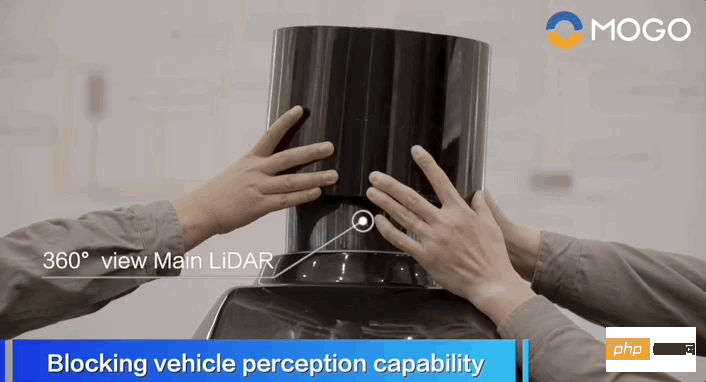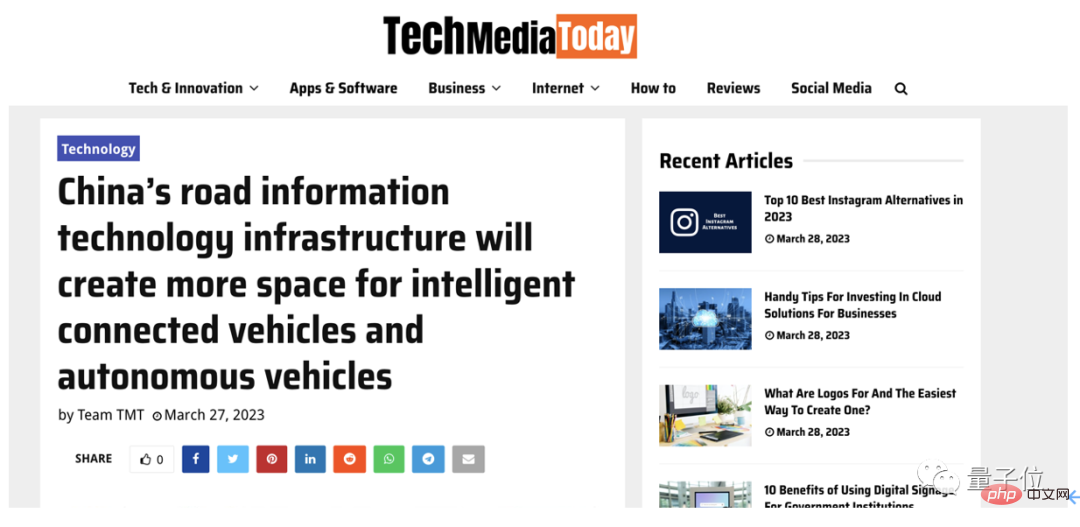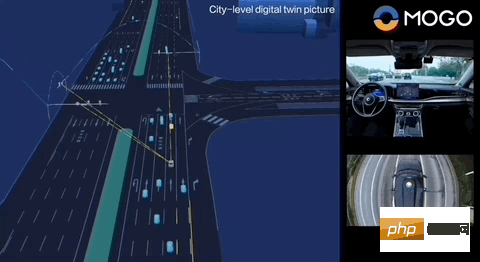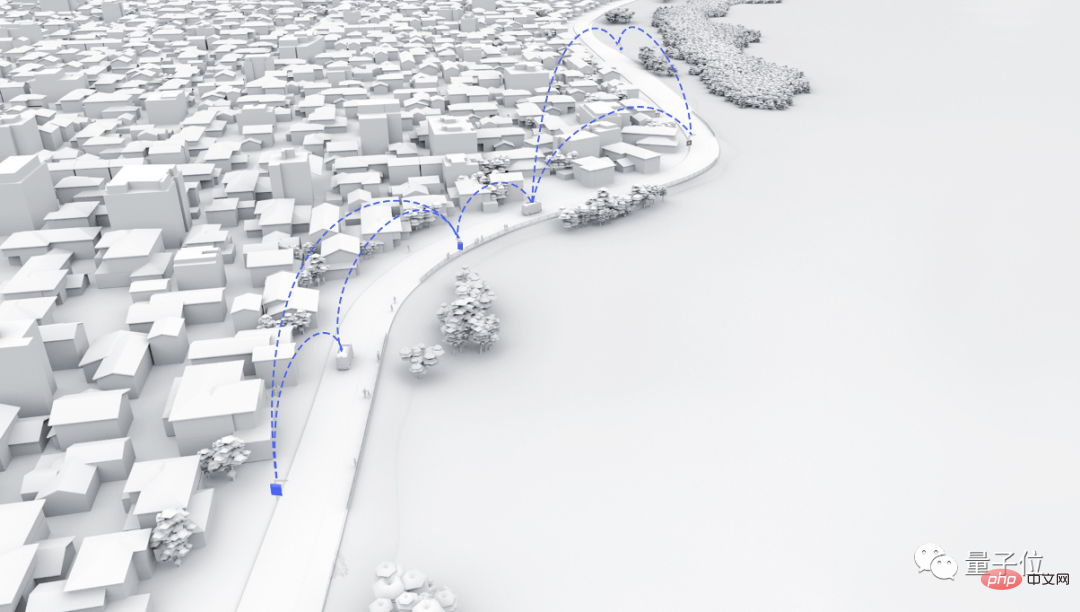Home >Technology peripherals >AI >All the sensors of unmanned vehicles 'failed', but they can still drive smoothly on urban roads. The black technology behind them has become popular overseas.
All the sensors of unmanned vehicles 'failed', but they can still drive smoothly on urban roads. The black technology behind them has become popular overseas.
- WBOYWBOYWBOYWBOYWBOYWBOYWBOYWBOYWBOYWBOYWBOYWBOYWBforward
- 2023-04-07 22:31:011522browse
This article is reprinted with the authorization of AI New Media Qubit (public account ID: QbitAI). Please contact the source for reprinting.
"Musk, do you believe that V2X AI can make autonomous driving easier to implement?"
In the past two days, many well-known overseas technology UP owners, such as Karl Conrad, Dom Esposito, Shane starnes , Jonathan Casey, constantly following a video on self-driving roadside technology @Musk, waymo, cruise and other technology tycoons and well-known companies.


In the video, the self-driving vehicle handles the complex roads in open urban areas without taking over the whole process, but this is not what surprises everyone. point. What’s truly incredible is that the vehicle in the video completely blocks all on-board sensors. This means that this smart car has almost become an invisible "blind person".

You must know that L4 autonomous driving on urban open roads is realized only through roadside intelligent equipment. This is likely to be the first time in the world!
The entire autonomous driving process is completed by Mogo AI Digital Road Base Station 2.0 (Mogo AI Station 2.0) to complete sensing, calculation, and communication, and issues traffic light status, pedestrian warning, road condition warning, front vehicle braking warning and other information To vehicles, it helps smart cars safely perform difficult actions such as right-of-way game, speed increase, overtaking, and autonomous lane changing.

Such capabilities have caused these overseas technology KOLs to repost and exclaim:
China’s digital road technology is already at the forefront , it is very likely to formulate industry standards.
Moguolian from China brings self-driving cars into reality through "AI V2X infrastructure".
so cool! In cities with V2X infrastructure, autonomous vehicles will be more likely to be deployed on a large scale!
The internationally renowned technology media TechMediaToday and TGDaily also reported this incident on March 27 and 28, local time respectively.

TechMediaToday, an emerging technology news website with a large number of young readers, pointed out in the report: "Moguchi Auto Connect is just a microcosm of Chinese technology companies. China's autonomous driving technology is developing in a Growing at an incredible speed."

The world-renowned technology media TGDaily, founded in 1998, reported: "China's Mushroom Auto Connect will participate in "car-road-cloud" transportation The elements are organically connected to provide more comprehensive traffic information for intelligent connected cars and improve the safety of autonomous driving."
What kind of capabilities does it show?
In the video, the vehicle safely completes the L4 level autonomous driving task on urban open roads while blocking all sensors on the vehicle. The vehicle can handle multiple complex road sections with ease.
For example, at an intersection, the Mushroom AI digital base station will send traffic lights to vehicles in advance.

If it is a "traditional" self-driving vehicle, this process involves the vehicle-side camera capturing image data, which is then identified by an algorithm.
But this time the self-driving car camera has been blocked, so the traffic light results are transmitted to the self-driving car through the roadside intelligent device to realize the recognition and response of the traffic light.
For another example, when faced with pedestrians crossing the road, vehicles will proactively take avoidance actions in advance:

For previous ADAS, in addition to the images captured by the camera Data, for such sudden obstacle targets, lidar data is usually required as a redundant guarantee for mutual verification of systems.
But this time even the lidar on the car was blocked.
He made ADAS "blind" and took away the "guide crutch" in his hand, relying entirely on roadside equipment to input data for the vehicle to make decisions.

Real-time traffic conditions on the road include dynamic target vehicles and people, traffic signs and lights at the infrastructure level, as well as road emergencies, accidents, construction, etc. Based on advanced artificial intelligence algorithms, the AI digital road base station installed at the road end senses, identifies, and calculates in real time, and then sends it to the vehicle.
In other words, in addition to taking "avoidance", this system can also complete more advanced automatic driving actions.
For example, in the face of low-speed vehicles, the roadside intelligent base station will provide relevant decision-making data to help the vehicle actively change lanes and overtake:

There are also intersections Unprotected steering:

# There is no active input from any vehicle-side sensors, but judging from the amount of traffic data obtained and the computing power requirements of the AI algorithm, the road in the video Side technology provides further, more, richer and more timely data at the security level, as well as secure double redundancy.
Using the cloud system to control the traffic flow of a certain area section from a global perspective can also maximize traffic efficiency and reduce accidents.
This is also the reason why this video that does not rely on vehicle-side sensors and only uses roadside technology to achieve autonomous driving has become popular overseas.
Contrary to the traditional autonomous driving technology route, behind the amazing results, there are more dimensions worthy of comparison and discussion.
What kind of system is this?
This video that shocked the foreign technology circle comes from Moguolian Automobile Alliance, a domestic autonomous driving technology company that focuses on vehicle-road-cloud integration.
Their standardized product integrating software and hardware is called Mushroom AI Digital Road Base Station 2.0. It is the infrastructure for road digitalization and can be deployed on a large scale and quickly on urban roads, highways, Scenic spots, parks, etc.

##△ Urban scene

△ High speed scene

##△
Scenic RoadThe 6-minute measured road section in the video is located on the main road in Hengyang City, Hunan Province, crossing the city center. MOU has built and upgraded a 38-kilometer digital road here, and deployed its self-developed AI digital road base stations on a large scale.
Moguchi AutoLink’s AI digital road base station is actually a software and hardware integrated product. It includes an edge computing component (MEC), a vehicle-road collaboration communication unit (RSU), and a variety of sensor components. The self-developed intelligent road system runs on the MEC to realize multi-modal perception fusion and V2X computing engine.
It can be deployed every few hundred meters on traffic signal poles, gantry and other infrastructure on the road to form continuous sensing coverage without blind spots and provide continuous vehicle-road collaborative network coverage along the road.
Intuitive understanding is to obtain the real-time status of the road through the sensors deployed in the base station, and then perform calculations through edge computing devices, and then "tell" the vehicle through the high-performance communication module, and the autonomous vehicle will perform specific actions.
Compared with road information collected purely by vehicle-side sensors, the Mushroom AI digital road base stations deployed on both sides of the road have a wider field of view and a longer distance. It even forecasts traffic conditions kilometers away. Especially to avoid accidents like "ghost probe".
Currently, Hengyang’s 38 kilometers of digital roads can process an average of 46.2TB of data flow per day, analyze 1.85 billion frames of sensory data, identify traffic participants 1.964 million times, issue light status information 25.92 million times, and calculate 23.7 V2X events. billion times, with 27.37 million vehicle-road collaborative interactions. About 5,000 intelligent connected cars interact with Mogo AI Digital Road Base Station 2.0 (Mogo AI Station 2.0) every day.
Secondly, Mushroom Digital Road Base Station also has super data processing capabilities and ultra-low full-link delay. The total computing power of the entire 38-kilometer journey exceeds 10,000 TFlops, which is beyond the computing power of a single bicycle. At the same time, the algorithm based on the vehicle-road-cloud integrated system can help autonomous driving terminals make timely and rapid decisions. The system's response speed can reach within 100 milliseconds, which is three times faster than human reaction speed.

# In addition to supporting L4 level autonomous driving, this digital road base station can also data empower other L1-L3 vehicles in the area. And not only passenger cars, in theory all commercial vehicles and low-speed unmanned vehicles connected to the system can obtain powerful data support and services from the base station.
As the construction of digital roads accelerates, the data obtained by digital base stations will increase exponentially, and can feed back AI algorithms to make the system more intelligent, ultimately reducing traffic accidents and improving traffic conditions as a whole.
Moguchi AutoLink’s approach is a bit like chatGPT. They both solve problems from the bottom up. Autonomous driving is like many technologies. The reason why it has not performed well in the past many years is that under the background of algorithm convergence, not enough data can be obtained and the computing power is not strong enough.
Moguchi AutoLink’s digital road base station fundamentally solves the problem of data ("God" perspective, beyond line of sight, comprehensive information without dead ends) and computing power (edge computing, vehicle-side computing, cloud computing) from a system perspective. Computing multiple superpositions will constitute an unprecedented supercomputer problem. A large number of base stations generate massive amounts of data 24/7, helping large autonomous driving models achieve rapid iteration and evolution, which may bring unimaginable changes to the development of autonomous driving technology.
Another possibility for China to develop autonomous driving
The reason why this video has aroused heated discussion is that, in addition to the technological accumulation of Mushroom AutoLink, it has come up with a sufficient "black technology" approach Side products, another reason is that this kind of autonomous driving technology route can almost only be realized in China, which makes many overseas colleagues very envious. Once a system like Mushroom AutoLink is built, it will provide almost all-round basic autonomous driving services required by various L1-L4 vehicles regardless of vehicle or road section.
For the large-scale implementation of such V2X, currently only China’s digital road infrastructure is complete enough, the market is large enough, and the policies are active enough, which means it has more advantages than foreign implementations.
After the release of the roadside capability video, Moguolian also released a bicycle autonomous driving video, which also achieved L4 autonomous driving capabilities on urban open roads.
The vehicle end and the road end cooperate, and the two systems are redundant to each other, which improves the reliability of the entire autonomous driving.
Coupled with the cloud platform behind it, it truly realizes the "vehicle-road-cloud integration" that the country has been advocating.
KOLs and media in overseas technology circles marvel at the roadside technology of Mushroom AutoLink. An important reason is that the bicycle intelligence represented by Tesla has almost become the only self-driving classic after years of preaching by Musk. dogma. However, Moguchi AutoLink only used the Moguchi AI digital road base station to achieve L4 level autonomous driving on urban open roads, showing them a possible path for autonomous driving to be more robust and reliable and with better overall social economic benefits.
And they have @Musk and technology companies such as cruise and waymo. In fact, there is an unexpressed subtext-
Such a method may not be possible overseas.
The above is the detailed content of All the sensors of unmanned vehicles 'failed', but they can still drive smoothly on urban roads. The black technology behind them has become popular overseas.. For more information, please follow other related articles on the PHP Chinese website!
Related articles
See more- Technology trends to watch in 2023
- How Artificial Intelligence is Bringing New Everyday Work to Data Center Teams
- Can artificial intelligence or automation solve the problem of low energy efficiency in buildings?
- OpenAI co-founder interviewed by Huang Renxun: GPT-4's reasoning capabilities have not yet reached expectations
- Microsoft's Bing surpasses Google in search traffic thanks to OpenAI technology

